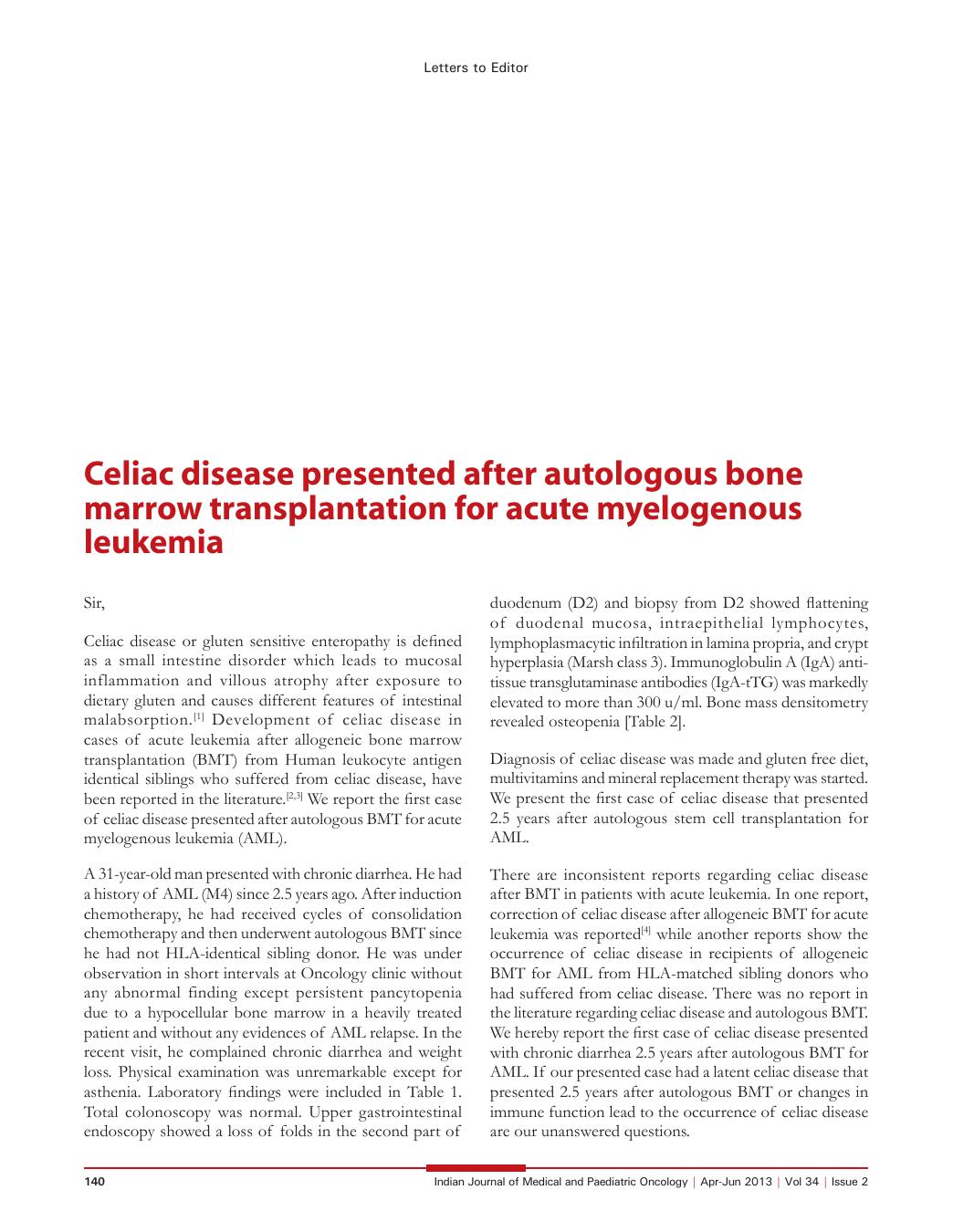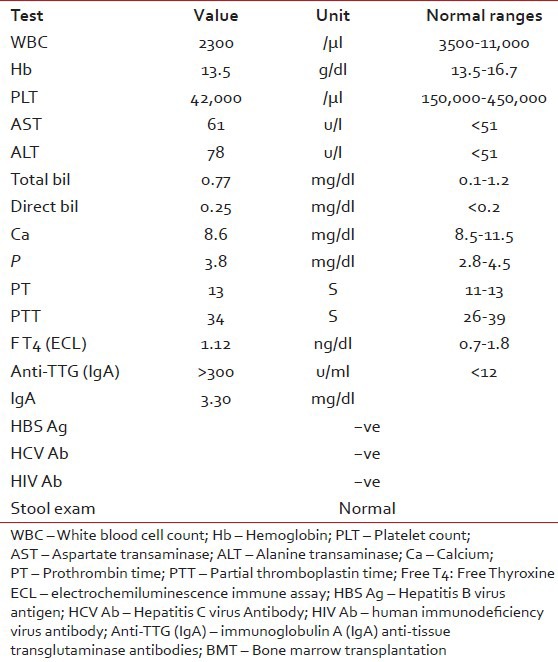Celiac disease presented after autologous bone marrow transplantation for acute myelogenous leukemia
CC BY-NC-ND 4.0 · Indian J Med Paediatr Oncol 2013; 34(02): 140-141
DOI: DOI: 10.4103/0971-5851.116227

Publication History
Article published online:
20 July 2021
© 2013. Indian Society of Medical and Paediatric Oncology. This is an open access article published by Thieme under the terms of the Creative Commons Attribution-NonDerivative-NonCommercial-License, permitting copying and reproduction so long as the original work is given appropriate credit. Contents may not be used for commercial purposes, or adapted, remixed, transformed or built upon. (https://creativecommons.org/licenses/by-nc-nd/4.0/.)
Thieme Medical and Scientific Publishers Pvt. Ltd.
A-12, 2nd Floor, Sector 2, Noida-201301 UP, India
Sir,
Celiac disease or gluten sensitive enteropathy is defined as a small intestine disorder which leads to mucosal inflammation and villous atrophy after exposure to dietary gluten and causes different features of intestinal malabsorption.[1] Development of celiac disease in cases of acute leukemia after allogeneic bone marrow transplantation (BMT) from Human leukocyte antigen identical siblings who suffered from celiac disease, have been reported in the literature.[2,3] We report the first case of celiac disease presented after autologous BMT for acute myelogenous leukemia (AML).
A 31-year-old man presented with chronic diarrhea. He had a history of AML (M4) since 2.5 years ago. After induction chemotherapy, he had received cycles of consolidation chemotherapy and then underwent autologous BMT since he had not HLA-identical sibling donor. He was under observation in short intervals at Oncology clinic without any abnormal finding except persistent pancytopenia due to a hypocellular bone marrow in a heavily treated patient and without any evidences of AML relapse. In the recent visit, he complained chronic diarrhea and weight loss. Physical examination was unremarkable except for asthenia. Laboratory findings were included in Table 1. Total colonoscopy was normal. Upper gastrointestinal endoscopy showed a loss of folds in the second part of duodenum (D2) and biopsy from D2 showed flattening of duodenal mucosa, intraepithelial lymphocytes, lymphoplasmacytic infiltration in lamina propria, and crypt hyperplasia (Marsh class 3). Immunoglobulin A (IgA) anti-tissue transglutaminase antibodies (IgA-tTG) was markedly elevated to more than 300 u/ml. Bone mass densitometry revealed osteopenia [Table 2].
Table 1
Laboratory findings 2.5 years after autologous BMT

Table 2
Results of bone mass densitometry

Diagnosis of celiac disease was made and gluten free diet, multivitamins and mineral replacement therapy was started. We present the first case of celiac disease that presented 2.5 years after autologous stem cell transplantation for AML.
There are inconsistent reports regarding celiac disease after BMT in patients with acute leukemia. In one report, correction of celiac disease after allogeneic BMT for acute leukemia was reported[4] while another reports show the occurrence of celiac disease in recipients of allogeneic BMT for AML from HLA-matched sibling donors who had suffered from celiac disease. There was no report in the literature regarding celiac disease and autologous BMT. We hereby report the first case of celiac disease presented with chronic diarrhea 2.5 years after autologous BMT for AML. If our presented case had a latent celiac disease that presented 2.5 years after autologous BMT or changes in immune function lead to the occurrence of celiac disease are our unanswered questions.
ACKNOWLEDGMENT
Special thanks to all Doctors, Nurses and Staffs of Hematology/Oncology and Stem Cell Research Center in Shariati Hospital of Tehran University of Medical Sciences who performed autologous bone marrow transplant for this patient. We express our appreciation to Drs. Behruz Ilkhanizadeh the pathologist and Samaneh Abedidost resident of the Pathology in Urmia University of Medical Sciences who reported pathologic findings of duodenal biopsy of this case.


 PDF
PDF  Views
Views  Share
Share

